Purpose of Program
Use this program to enter and modify purchase order records for your vendors. A purchase order can include both regular and non-inventory (non-stock) items.
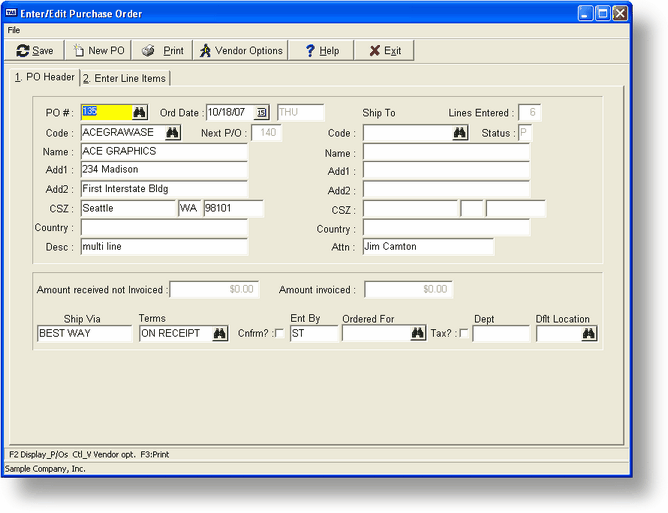
Field Explanations
P/O # (Required)
The purchase order number. Usually you will allow the program to assign a default—the next purchase order number—for you. If the number the program tries to assign corresponds to an existing purchase order, the next available purchase order number will be used. To specify a number other than 1 for your first purchase order number at system startup, use SY-A-A, Enter/Chg Comp Interface.
You can enter a number in this field or Click use F2 to select from a list to call up an existing purchase order for alterations, deletions or additions.
Order Date
The date the purchase order is entered (defaults to the current date).
Purchase Information
Code (Required)
The code for the vendor making the purchase. You can Click or use the F2 key to get a list of vendors on file.
Next P/O
The next purchase order number as recorded in SY-A-A.
Name
Add1
Add2
CSZ (City State Zip)
Cntry (Country)
Default entries from the vendor record (created in AP-A, Enter/Chg Vendors). You can use an alternate vendor address by accessing the Alternate Address file create in AP-A. To get a list of addresses available press the ^V (CTRL+V) key and choose option 1 (Alt Purch from Addresses) from the menu. This will give you the standard Alternate Address list and you can choose the appropriate one. For more information pleas refer to Vendor Options below.
Desc
The general description for this purchase order (optional). This will be printed on all reports and on the vendor's check.
Attn
The person to whose attention this order should be addressed. The default value is the contact person in the vendor record. You can use an alternate contact for this vendor. For more information please see Vendor Options below.
Amount received not invoiced
The dollar amount received on this P/O that has yet to be invoiced.
Amount invoiced
The dollar amount received on this P/O and invoiced.
Ship To
If this is a 'drop ship' order you may enter the customer's address here. To get a list of customers press the F2 key. You can also access the customer's alternate address file. For more information about this please refer to Vendor Options below.
Lines entered
The number of line items that have been entered on this P/O.
Status
The P/O status, can be blank - no receipts and not yet printed, Y - printed, P - partial receipt, R - received, C - closed.
Ship Via
The method of shipment. This field will default to a value set up in SY-A-C, Enter/Chg A/P P/O Defaults.
Terms (Required)
Chosen from a pop-up menu, with the default entry from the vendor record highlighted.
Confirm?
If this is a confirming order only enter Y here.
Ent by
The person who entered the order. This field will default to a value set up in SY-A-C, Enter/Chg A/P P/O Defaults.
Ordered For
If this order is for a specific customer you may enter their code here. To get a list of customers press the F2 key.
Tax (Required)
Enter Y if any item on this order is taxable. Enter N if none are taxable. This defaults to the value entered in SY-A-C, Enter/Change A/P P/O Defaults for the field P/O Dflt Taxable.
Dept
If you are using G/L departments, this field allows optional entry of a G/L Department Code to post the purchase to a specific department set up in your Chart of Accounts.
![]() **VERY IMPORTANT** If you specify a department value here you must be careful that all transactions, including sales tax liability, etc., have the same department code. If you don't you will not be able to get a balanced departmentalized trial balance. This also applies to the G/L accounts in the actual inventory records.
**VERY IMPORTANT** If you specify a department value here you must be careful that all transactions, including sales tax liability, etc., have the same department code. If you don't you will not be able to get a balanced departmentalized trial balance. This also applies to the G/L accounts in the actual inventory records.
Location
If you are using multiple inventory locations (set up as part of the inventory record in IC-A, Enter/Chg Inventory), enter the appropriate location here. See Using Multiple Locations for more information.
The Display Window and the Line Item Entry Window
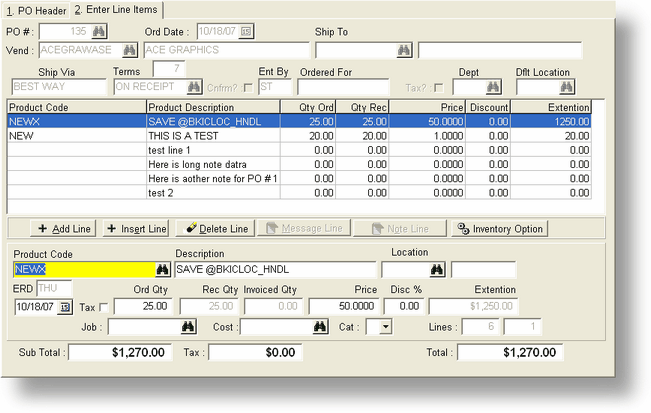
Once you enter the purchase and shipping information the screen changes to that above.
The lower half of the purchase order entry screen includes a display area which shows information for up to ten items on the purchase order. After entering a line item using the entry window, the item is moved to the scrolling display area. You can use the UP and DOWN ARROW keys to choose a line item if you need to modify any information. You can see different information on a line item in the entry window than what you see about it in the scrolling area; be sure to view a line item in both modes for full information about the item.
Line Item Entry Window - Inventory Item

Product Code
This is the first entry field. Inventory product codes are set up in IC-A, Enter/Chg Inventory. You can select from a list of inventory items or you can type in a product code. As you press ENTER after you have selected a product code, the inventory product description is displayed next to the code. You can change the product code description for this particular purchase order. If the product is not yet in the inventory file the program will allow you to add it.
Once you have entered a product code and the item is displayed you can access the full inventory record for that item by pressing ^I (CTRL+I) and choosing option 5 from the menu. This option will also let you add a free form note to this line item, choose a note already saved for the inventory item or delete a note previously attached. For more information about these options please refer to Inventory Options below.
To enter a message instead of an inventory item press just the ENTER key here (leave the product code blank).
Loc
The location for this product. This will default to what you have entered on the first page.
NOTE
If the word NOTE appears next to the Tax value then you have a note attached to this line item.
ERD
The Estimated Receipt Date. The default value in this field is the current date. The actual day name will also be displayed.
Tax
If you entered Y in the Tax field above, you can also choose whether individual line items are taxable. You are offered a default from the inventory file. If you entered N in the Tax field above, this field will always be N.
Qty (Required)
The number of units ordered. This is a seven digit numeric field with two decimal characters.
Rec
The number of units received to date for this line item.
Price (Required)
The unit price (cost) for this line item.
Disc
If you are given a discount on this line item enter it here. Ten percent is represented as '10.00.'
Ext
The Qty ordered multiplied by the net price per unit.
Line Item Entry Window - Message

To enter a message instead of an inventory item press just the ENTER key at the Product Code field.
Enter Message:
You may enter a 65 character message here. This will appear on the purchase order.
You can also use the same note entry process for a message as for inventory line items. When the cursor is in the actual message field press the ^N (CTRL+N) key. For more information on message line purchase order notes please refer to Message Line Notes, below. If you save a note the first line is displayed in the normal message line area.
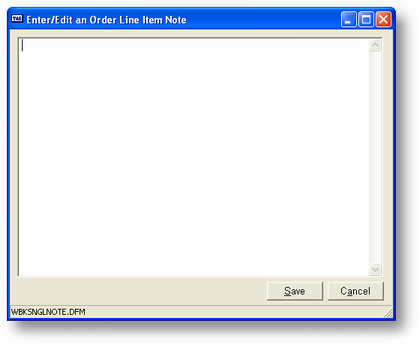
Totals

Sub Tot
The sub-total amount for the purchase order for all items (calculated automatically and displayed as a running sub-total).
Tax
The amount of tax for this purchase order (calculated automatically when you save the purchase order).
Total
The total amount of the purchase order. This is the Sub-total + Tax.
General Program Operation
Adding a New Purchase Order
Press ENTER when you are in the Purchase Order # field, and the program will automatically assign a number when the purchase order is saved.
Enter a complete vendor code, or use the F2 list display option to select a vendor.
Press ENTER again, and the vendor information will be displayed. You may change any field associated with this vendor for this particular purchase order; however, the new information will not be saved in the vendor record, If you want to change information in the vendor file, use AP-A, Enter/Change Vendors or press the ^V (CTRL+V) key to access the complete vendor record while you are entering a P/O.
If you enter a vendor code that isn't in the vendor file, you will be able to enter a new vendor at this point and then return to the purchase order process. (For more information on adding a vendor record, see AP-A, Enter/Change Vendors).
Next, you can enter the ship to information, if any. Press ENTER while in the blank Code field on the right side of the screen if the items should be shipped directly to you. For a drop ship order enter the customer's address here. To get a list of customers press the F2 key. You can also access a customer's alternate address list. To do this please see Vendor Information Options below.
You can enter a general description for the purchase order. This description will appear on posting reports and the vendor check.
The Ship Via information offers a default entry from SY-A-C, Enter/Chg A/P P/O Defaults.
The Terms field will display the choices available to you. The terms menu will highlight the default set in the vendor record. Cash terms (types A or C in SY-B) post directly to a cash account—no Accounts Payable line items are created.
The final entries in the purchase order header are as follows:
| · Confirm? - If this is a confirming P/O only then enter Y here. |
| · Ent by - You can enter the initials or another identifying memo for the person who entered the purchase order. This field is not required. |
| · Ordered For - If this P/O is for a specific customer then enter their code here. To get a list of customers press the F2 key. |
| · Tax - Enter Y if any item on the purchase order is taxable. |
| · Dept - If you are using G/L departments, enter the G/L department to which transactions are to be posted. |
· Location - If you are using multiple inventory locations, enter the inventory location this order is for. Use F2 to select from available locations while the cursor is in this field. You can only use one location per purchase order. If you have only one location on file this entry is bypassed.
Purchase Order Line Items
You can enter up to 250 line items on a single purchase order. To add a new line move the cursor to a blank line and press the ENTER key. Enter items from the inventory file by typing in a complete product code or using the list display (F2) option to select an item. With the F2 option, you will see the number of units on hand at the specified location. The program will place the product code in the appropriate field. To display the balance of the information for that item, press ENTER. The description from the inventory file will appear along with the last cost as listed in the product record. You must enter a quantity other than 0.
You can also enter messages. To do this, press ENTER in the blank Product Code field. The window above is displayed and you can enter up to 65 characters.
Both regular (physical) and non-inventory type items can be entered on the same purchase order. In the case of non-inventory items the costs involved will be posted directly to the expense account you specified in IC-A, Enter/Chg Inventory.
Enter the estimated receipt date and taxable (Y or N). Quantity ordered and price (cost) are next. The program will automatically calculate the extension.
The program then asks if the line entry is correct. If you enter Y, the line will be added to the list above the entry line, and the purchase order sub-total amount will be updated. This is called "accepting" a line item.
If you were adding a new line the cursor will automatically go to the next blank line and you can enter another line item by pressing the ENTER key. To change a line move the cursor to the appropriate line and press the ENTER key (notice how the entry window below changes as you move the cursor). To insert a line move the cursor to the line you want to insert before and press the INSERT key.
Deleting a Line Item
Move the cursor to the appropriate line and press the DELETE key.
Saving the Purchase Order
After you have entered all the line items for the purchase order, press F10 while in the list window. If you press the F10 key while in the entry window the program will give you instructions on how to properly save the line item.
When you are finished saving the purchase order the program will ask if you wish to print the P/O now. If you enter Y the program will chain to PO-B, Print P/O's on Forms. Saving a purchase order updates the units on P/O in the inventory record and the inventory location file, saves the purchase order header and line item information, and increments the Next Purchase Order Number in SY-A-A, Enter/Change Company/Interface.
Changing an Existing Purchase Order
A previously entered purchase order may be changed any number of times as long as it is not closed (see PO-D, Receive P/O's). Once a purchase order has been closed, however, the line items included on that P/O cannot be changed or deleted and no new line items can be added. To make any modification after posting, you must enter a reversing purchase order (see Reversing a Purchase Order below).
To find an existing purchase order, use one of the following two options:
| · Enter the purchase order number in the P/O # field. |
· Use the list display option (press F2 while the cursor is in the P/O # field).
To display the rest of the information for that purchase order, press ENTER to view the balance of the information for that purchase order. The vendor and/or product line item information can be changed by moving the cursor to the appropriate fields and typing in the new information. Press the PAGE DOWN key to get to the line item screen. The purchase order number itself cannot be changed without deleting and re-entering the purchase order.
Reversing a Purchase Order
If you need to reverse the effect of a closed purchase order, (for example in the case of a return to a vendor) enter a new purchase order with line items identical to those on the invoice, except that you must enter negative Quantity amounts. When the P/O is 'received', the second purchase order adds offsetting detail line items to the General Ledger, inventory record, and vendor record, balancing and reversing the first P/O. This is sometimes known as a "credit purchase order." You must receive this P/O just like you would a normal one to get the effect on the various files.
![]() You may enter both negative and positive Quantity amounts on the same purchase order.
You may enter both negative and positive Quantity amounts on the same purchase order.
Deleting an Existing Purchase Order
Find the existing purchase order using the methods above in the Changing an Existing Purchase Order. With the cursor in the Order Date field press the F4 key. The program will ask if you want to delete the entire purchase order. If you answer Y, the purchase order will be deleted from the file, and any unposted invoices are also deleted. If you answer N the program will return you to the P/O # field.
Deleting a purchase order reverses the operations described above for saving a purchase order.
Vendor Information Options
If you press the ^V (CTRL+V) key when the cursor is on the first page screen or when in the item list (not during item entry) the following menu will be displayed:

1 - Alt Purch From Addresses - Choose this option to get a list of the alternate addresses for the vendor so that you can choose one for the Purchase From name and address. This option can be chosen any time the vendor option menu is available. If you choose an address from the list it will automatically update the current purchase from information. If you press the ESC key while in the list nothing will change.
You can also add new alternate addresses here by pressing the INSERT key. The entry process is the same as in AP-A, Enter/Change Vendors. Once a new alternate address is saved you can then move the cursor to that line and choose it by pressing the ENTER key.
You can delete an existing alternate address by moving the cursor to that line and pressing the DELETE key. The program will ask you to confirm the deletion. If you enter Y the address line will be deleted from the list.
2 - Alt Ship To Addresses - Choose this option to get a list of the alternate addresses for the drop ship customer. This option can be chosen any time the vendor option menu is available. You are given the choice, when you choose this option, to list main addresses or alternates for your customers. Enter M for Main or A for Alternate. You cannot add or delete alternate addresses from this option.
3 - Alt Attention Of - Choose this option to get a list of alternate contacts for the vendor so that you can choose one for the Attn field. This option can be chosen any time the vendor option menu is available. If you choose a contact from the list it will automatically update the current Attn value. If you press the ESC key while in the list nothing will change.
You can also add new contacts here by pressing the INSERT key. The entry process is the same as in AP-A, Enter/Change Vendors. Once a new contact is saved you can then move the cursor to that line and choose it by pressing the ENTER key.
You can delete an existing contact by moving the cursor to that line and pressing the DELETE key. The program will ask you to confirm the deletion. If you enter Y the contact line will be deleted from the list.
5 - Vend Record - There are occasions when you need to change information directly in the vendor record. If you didn't start this process from the vendor record, or, if you want to get a list of other purchases, outstanding invoices, etc., choosing this option will return you to the main vendor record in AP-A, Enter/Change Vendors. You will not be able to start another purchase order for this vendor or delete their record, but just about anything else can be changed or displayed. It's important to note, however, that any changes made to the main vendor record will NOT be automatically copied to the current purchase order. When you exit from AP-A you will return to where you were in the purchase order.
Inventory Information Options
If you press the ^I (CTRL+I) key when the cursor is in the line item entry screen the following menu will be displayed:
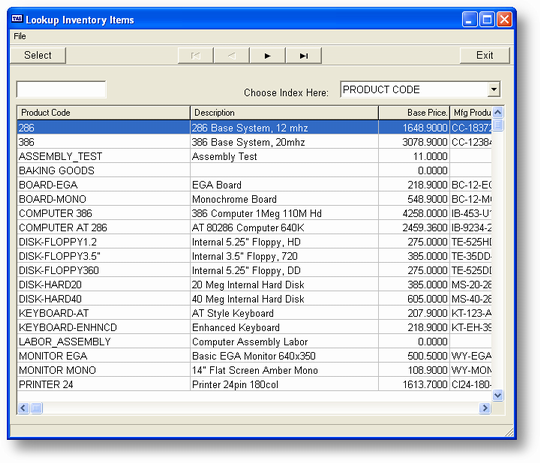
After you chhose an item this information screen is displayed.
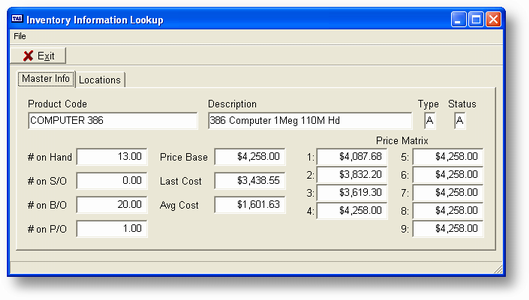
1 - Edit Attached Note - Free form (multi-line, automatic word wrap during entry and display) notes may be attached to any line item. These notes can be printed on the purchase order. You can use these notes to better explain the line item, give special instructions to your vendor, or keep track of who this specific item is for.
You can also attach a free form line item note to a message line. For more information please refer to Message Line Notes below.
If you choose this option, and there is not a note already attached to this line item, the screen above is displayed. Enter your note just as you would normally. The lines automatically wrap. The same key options that are available for TASNotes notes are also available here. When you are finished entering the note press the F10 key to save it. If you do not wish to save the note press the ESC key. If you have made changes to the note and press the ESC key the program will ask you if you're sure you want to discard the changes made.
If you save a note for this line item the word NOTE will appear to the right of the tax field. That note will remain attached to the line item even after it is received. You will still be able to refer to it in the P/O history.
2 - Delete Attached Note - Choose this option to delete a note that is already attached to the line item. You will be asked to confirm the deletion.
3 - Choose Inventory Note - By choosing this option you can attach a TASNote previously entered for this inventory item to this purchase order line item. A list of notes available will be displayed. Move the cursor line to the appropriate note and press the enter key. The note will be automatically attached to the line item. If you want to make further changes to the note then choose option 1. The note you chose here will be displayed and you will be able to make changes to it.
4 - Edit Inventory Notes - This is the standard TASNotes procedure and it will allow you to add new notes or change existing ones that are attached to this inventory item. After entering a new note here you can then choose option 3 to attach it to the line item, and then option 1 to make further changes, if desired.
5 - Inventory Record - There are occasions when you need to change information directly in the inventory record or if you want to get other information not available on the screen, choosing this option will return you to the main inventory record in IC-A, Enter/Change Inventory. You will not be able to delete the record, but just about anything else can be changed or displayed. When you exit from IC-A you will return to the line item entry.
Message Line Notes
You can also use this option when entering message lines. When the cursor is in the message line field press the ^N (CTRL+N) key. If this is a new message line (or there is no purchase order note attached to the line) the same note screen will be displayed as for a regular inventory item. You can then enter your free form note and when you save it the first line will be displayed in the message line on the screen. If you need to edit it again later just move the cursor to that line, press the ENTER key and the program will automatically display the note editing screen with the current note displayed. To delete a message line note (when attached to a message line only), move the cursor line to the appropriate message line on the list and press the DELETE key. You will be asked to confirm the deletion.
Printing an Existing Purchase Order or all Purchase Orders
If you choose this option the program chains to PO-C, Print Open P/O List. For more information please refer to that program.
Page url: http://www.cassoftware.com.com/adv7docs/index.html?po_a_enterchangepurchaseo.htm